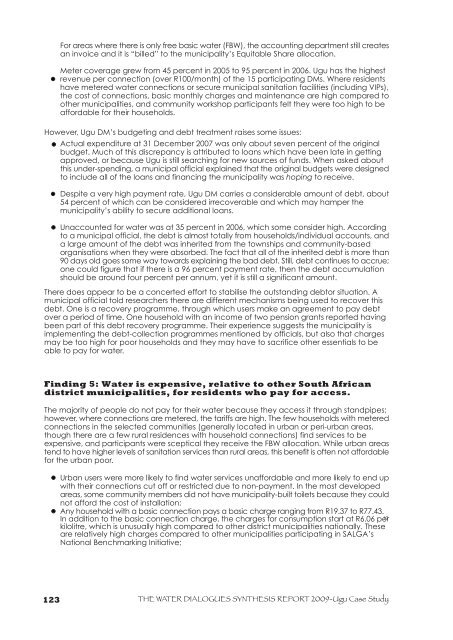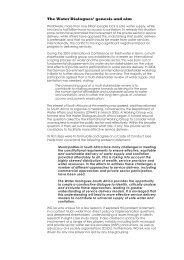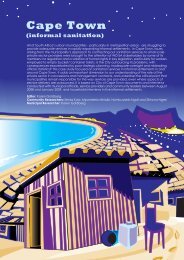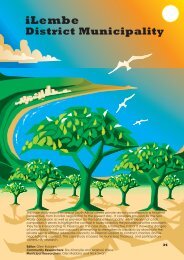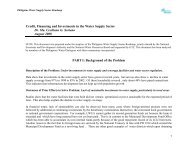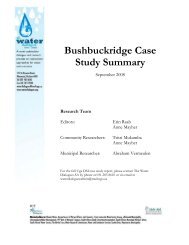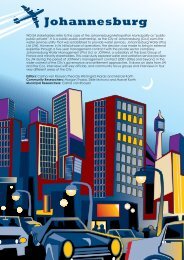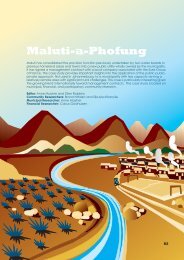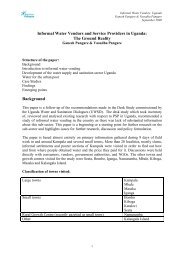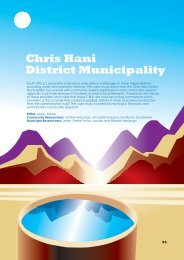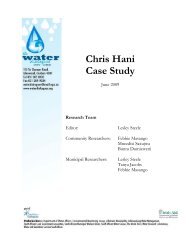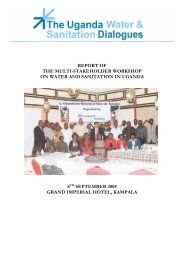Ugu Case Study Summary - The Water Dialogues
Ugu Case Study Summary - The Water Dialogues
Ugu Case Study Summary - The Water Dialogues
You also want an ePaper? Increase the reach of your titles
YUMPU automatically turns print PDFs into web optimized ePapers that Google loves.
For areas where there is only free basic water (FBW), the accounting department still creates<br />
an invoice and it is “billed” to the municipality’s Equitable Share allocation.<br />
Meter coverage grew from 45 percent in 2005 to 95 percent in 2006. <strong>Ugu</strong> has the highest<br />
revenue per connection (over R100/month) of the 15 participating DMs. Where residents<br />
have metered water connections or secure municipal sanitation facilities (including VIPs),<br />
the cost of connections, basic monthly charges and maintenance are high compared to<br />
other municipalities, and community workshop participants felt they were too high to be<br />
affordable for their households.<br />
However, <strong>Ugu</strong> DM’s budgeting and debt treatment raises some issues:<br />
Actual expenditure at 31 December 2007 was only about seven percent of the original<br />
budget. Much of this discrepancy is attributed to loans which have been late in getting<br />
approved, or because <strong>Ugu</strong> is still searching for new sources of funds. When asked about<br />
this under-spending, a municipal official explained that the original budgets were designed<br />
to include all of the loans and financing the municipality was hoping to receive.<br />
Despite a very high payment rate, <strong>Ugu</strong> DM carries a considerable amount of debt, about<br />
54 percent of which can be considered irrecoverable and which may hamper the<br />
municipality’s ability to secure additional loans.<br />
Unaccounted for water was at 35 percent in 2006, which some consider high. According<br />
to a municipal official, the debt is almost totally from households/individual accounts, and<br />
a large amount of the debt was inherited from the townships and community-based<br />
organisations when they were absorbed. <strong>The</strong> fact that all of the inherited debt is more than<br />
90 days old goes some way towards explaining the bad debt. Still, debt continues to accrue;<br />
one could figure that if there is a 96 percent payment rate, then the debt accumulation<br />
should be around four percent per annum, yet it is still a significant amount.<br />
<strong>The</strong>re does appear to be a concerted effort to stabilise the outstanding debtor situation. A<br />
municipal official told researchers there are different mechanisms being used to recover this<br />
debt. One is a recovery programme, through which users make an agreement to pay debt<br />
over a period of time. One household with an income of two pension grants reported having<br />
been part of this debt recovery programme. <strong>The</strong>ir experience suggests the municipality is<br />
implementing the debt-collection programmes mentioned by officials, but also that charges<br />
may be too high for poor households and they may have to sacrifice other essentials to be<br />
able to pay for water.<br />
Finding 5: <strong>Water</strong> is expensive, relative to other South African<br />
district municipalities, for residents who pay for access.<br />
<strong>The</strong> majority of people do not pay for their water because they access it through standpipes;<br />
however, where connections are metered, the tariffs are high. <strong>The</strong> few households with metered<br />
connections in the selected communities (generally located in urban or peri-urban areas,<br />
though there are a few rural residences with household connections) find services to be<br />
expensive, and participants were sceptical they receive the FBW allocation. While urban areas<br />
tend to have higher levels of sanitation services than rural areas, this benefit is often not affordable<br />
for the urban poor.<br />
Urban users were more likely to find water services unaffordable and more likely to end up<br />
with their connections cut off or restricted due to non-payment. In the most developed<br />
areas, some community members did not have municipality-built toilets because they could<br />
not afford the cost of installation;<br />
Any household with a basic connection pays a basic charge ranging from R19.37 to R77.43.<br />
In addition to the basic connection charge, the charges for consumption start at R6.06 per<br />
10<br />
kilolitre, which is unusually high compared to other district municipalities nationally. <strong>The</strong>se<br />
are relatively high charges compared to other municipalities participating in SALGA’s<br />
National Benchmarking Initiative;<br />
123<br />
THE WATER DIALOGUES SYNTHESIS REPORT 2009-<strong>Ugu</strong> <strong>Case</strong> <strong>Study</strong>


